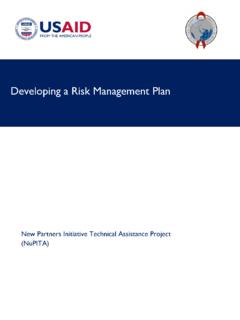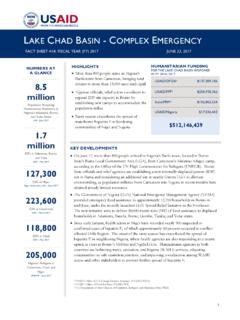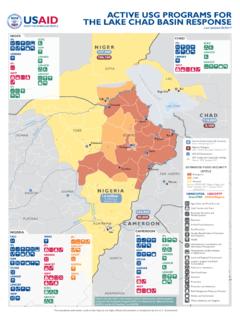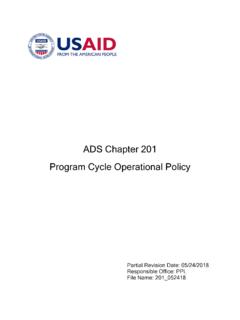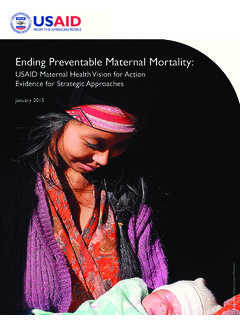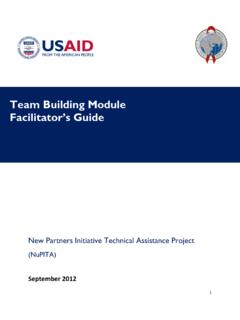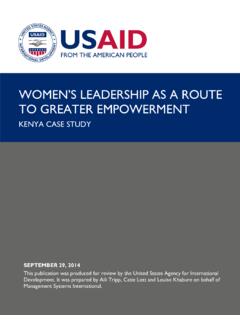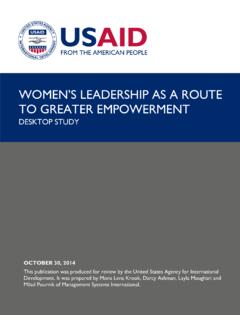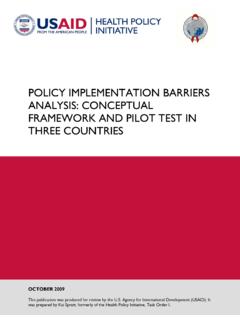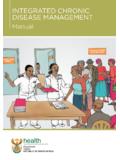Transcription of TECHNICAL ISSUE BRIEF - U.S. Agency for …
1 TECHNICAL ISSUE BRIEF CONDOM USE: HOW IT RELATES TO HIV AND STI PREVENTION Introduction The Agency for International Development (USAID) has been a leader in HIV prevention and is fully committed to doing its par t to make an AIDS-free generation a reality. The President s Emergency Plan for AIDS Relief s (PEPFAR s) combination HIV pre vention strategy comprises a core set of inter ventions that, par ticu larly when pursued in concer t, provide us with the potential to end the epidemic: prevention of mother-to-child transmission (PMTCT) of HIV; antiretroviral treatment (ART) for people living with HIV; voluntar y medical male circumcision for HIV prevention; and HIV testing and counseling (HTC), condoms and other evidence-based prevention activities.
2 Condom use is a critical element in a comprehensive, effective and sustainable approach to HIV across the continuum of response to all HIV epidemic types. The Effectiveness of Condoms in Preventing HIV and Sexually Transmitted Infections While no barrier method is 100 percent effective, correct and consistent use of latex condoms can reduce the risk of transmis sion of HIV, some other sexually transmitted infections (STIs) and unintended pregnancy. The use of condoms has been an impor tant and successful inter vention in many places for sexually active people, par ticularly when targeted at commercial and other casual sexual encounters. Correct and consistent use of condoms can aid in the preven tion of HIV and AIDS, other STIs and unintended pregnancy.
3 HIV While laborator y research has demonstrated that latex condoms provide an essentially impermeable barrier to par ticles comparable in size to or smaller than STIs, including HIV, studies have shown that correct and consistent use is essential to realize the full benefits pro vided by condoms in reducing the risk of HIV infection. The body of research demonstrating the effectiveness of latex condoms in reduc ing sexual transmission of HIV is both comprehensive and conclusive. In heterosexual serdiscordant relationships in which condoms were consistently used, HIV-negative par tners were 80 percent less likely to become infected compared with persons in similar relationships in which condoms were not used. However, failure to use con doms correctly with ever y act of intercourse has been shown to increase the risk of HIV transmission.
4 An educator demonstrates female condoms with students from the University of Yaound , Cameroon. Other STIs Condoms ser ve as a barrier that can protect both genders from exposure to genital secretions that transmit HIV and STIs. Gon orrhea, chlamydia and trichomoniasis, like HIV, are transmitted by genital secretions. Scientific studies have shown that latex condoms, when used consistently and correctly, can reduce the risk of gonor rhea and chlamydia infections in both women and men. Genital ulcer diseases (such as genital herpes, syphilis and chan croid) and human papillomavirus (HPV), which is the main cause of cer vical cancer, are transmitted primarily through contact with sores/ulcers or with infected skin in areas that may or may not be covered by a condom.
5 Recent studies have shown that correct and consistent condom use reduces the risk of herpes, syphilis, chancroid and HPV only when the infected area or site of potential exposure is protected by a condom. Additional research is needed to assess more accurately the de gree of risk reduction latex condoms can provide to women and men for trichomoniasis and other STIs transmitted by genital secre tions as well as whether and to what degree latex condoms may reduce the risk of acquiring the few types of HPV that are associ ated with cer vical cancer. Providing Condoms Worldwide USAID has provided commodities for family planning and repro ductive health activities since the mid-1970s and for HIV preven tion since the 1980s. Since then, contraceptive and condom use rates around the world have increased, in par t thanks to USAID ASSOCIATION CAMEROUNAISE POUR LE MARKETING SOCIAL(ACMS) Condom Shipment Quantities by Region, FY 2012 Latin America/Caribbean Europe/Eurasia 42 million (6%) 1 million (<1%) AfricaAsia 517 million (67%)209 million (27%) and other international donors.
6 However, the need for foreign assistance continues to grow, and in the FY 2012, USAID continued to respond to this need by providing condoms and other repro ductive health commodities to countries in four of the Agency s five regions: Africa, Asia, Europe and Eurasia and Latin America and the Caribbean. USAID has developed an operational plan for its HIV and AIDS strategy. One aspect of this plan includes a Commodity Fund to centrally finance male and female condoms for nonfocus PEPFAR countries HIV and AIDS programs and ensure their expedited de liver y to countries. Through this fund, USAID has made male and female condoms and lubricants available to dozens of countries at little or no cost. In FY 2012, the value of USAID condom shipments worldwide reached $ million.
7 Shipments reached 37 countries in Africa, Asia, Europe and Eurasia and Latin America and the Caribbean. USAID s Development Approach to Condom Promotion USAID-funded condom programs assist countries in ar ticulating a strategy for condom programming that addresses key supply and demand issues related to increasing condom use. USAID condom programs have adopted a Total Market Approach to condom pro gramming. A Total Market Approach engages the public, social mar keting and private sectors in segmenting condom distribution and promotion according to income level, and in planning for increased sustainability of condom programming by reducing reliance on do nor subsidies. Within a Total Market Approach, free public sector condoms will primarily be distributed to population segments lack ing disposable income and those most at risk of HIV transmission or acquisition.
8 Socially marketed condoms are sold to individuals with some ability to pay but who are not yet able to afford a more expensive, private sector condom, while private sector condoms are available to higher income segments of the population. When possible, social marketing programs adopt a phased process of gradually increasing cost recover y of social marketing products while simultaneously working with the private sector to improve the market share of sustainable, private sector condoms. USAID-funded condom programs distribute high-quality con doms through traditional outlets, such as health clinics and phar macies, and through nontraditional outlets, such as kiosks, bars, hotels and brothels. USAID-funded condom programs include programs to create demand for condoms as experience has demonstrated that these can increase condom sales and use.
9 USAID programs design high-quality behavior change communication and social marketing campaigns based on evidence-based theories relevant to a given setting and target population. For demand creation among sub groups, programs use a variety of formats, from individual to peer to community behavior change inter ventions. In general, multiple channels are deployed to reinforce key messages and in general ized epidemics, to ensure that all people receive motivational mes saging to use condoms. Female Condoms The female condom, a woman-initiated contraceptive, was first launched by the Female Health Company (FHC) in 1993 as the FC1, or the Reality FC. Since then, it has undergone changes, and FHC released the second generation of female condoms, the FC2.
10 This less expensive and more user-friendly redesigned female condom was approved for marketing by the Food and Drug Administration in March 2009. The FC2 has been reviewed by many agencies and, in 2006, the World Health Organization (WHO) recommended the FC2 to be purchased by agencies. The FC2 should provide the same level of protection from HIV, STIs and unintended pregnancy as male condoms, with some ad vantages. Female condoms give women more control in a sexual relationship, as it can be inser ted up to 8 hours before intercourse. It offers more protection than a male condom because it covers both internal and some par ts of the external genitalia. Men may also find it more comfor table because there is less of a decrease in sensation than with the male latex condom.
